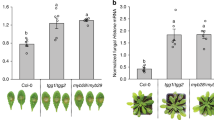Abstract
GLIOTOXIN was first described by Weindling and Emerson1 as a metabolic product of Trichoderma lignorum (Tode) Harz [= T. viride Pers. ex Fries]. Weindling afterwards2, on the advice of C. Thom and M. Timonin, reported that he had described the fungus incorrectly, and that instead it should be identified as a Gliocladium, similar to Gliocladium flmbriatum Gilman and Abbott. I have found that strains of Trichoderma viride produce gliotoxin, and I suggest that it is extremely probable that the fungus used, by Weindling was not G. fimbriatum, but was a Trichoderma as he originally supposed.
This is a preview of subscription content, access via your institution
Access options
Subscribe to this journal
Receive 51 print issues and online access
$199.00 per year
only $3.90 per issue
Buy this article
- Purchase on Springer Link
- Instant access to full article PDF
Prices may be subject to local taxes which are calculated during checkout
Similar content being viewed by others
References
Weindling, R., and Emerson, O. H., Phytopath., 26, 1068 (1936).
Weindling, R., Phytopath., 27, 1175 (1937).
Dutcher, J. D., J. Bact., 42, 816 (1941).
Gilman, J. C., and Abbott, E. V., Iowa State Coll. J. Sci., 1 (3), 225 (1927).
Bisby, G. R., Trans. Brit. Mycol. Soc., 23 (2), 149 (1939).
Author information
Authors and Affiliations
Rights and permissions
About this article
Cite this article
BRIAN, P. Production of Gliotoxin by Trichoderma viride. Nature 154, 667–668 (1944). https://doi.org/10.1038/154667b0
Issue Date:
DOI: https://doi.org/10.1038/154667b0
This article is cited by
-
Trichoderma: a Beneficial Antimycotic Agent and Insights on Its Utilization in Nanoparticle Synthesis
BioNanoScience (2023)
-
Trichoderma as a biological control agent: mechanisms of action, benefits for crops and development of formulations
World Journal of Microbiology and Biotechnology (2023)
-
Relationship between mycoparasites lifestyles and biocontrol behaviors against Fusarium spp. and mycotoxins production
Applied Microbiology and Biotechnology (2016)
Comments
By submitting a comment you agree to abide by our Terms and Community Guidelines. If you find something abusive or that does not comply with our terms or guidelines please flag it as inappropriate.



